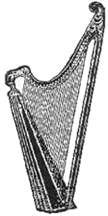|
             
Copyright
Helen Forder
2004
|
|
The
Harp, by Brinley Richards ...
continued
|
page 7
|
|
In the museum at South
Kensington may be seen a model of a very ancient Irish harp. The instrument
itself is still preserved in Trinity College, Dublin, and is probably the
oldest in Europe, if not in the world. In form and structure it closely
resembles the ancient Scotch harps previously alluded to. The one in Dublin
is said to have belonged to King Brian Borromh, in the tenth century. This,
however, is hardly correct; it more probably belonged to the O'Neils, an
illustrious Irish family, in the fourteenth century.
Robert Nugent, a Jesuit, in the fifteenth century, "considerably improved the Irish harp. He enclosed
the open space between the trunk and upper part, or arm, after the manner
of a box. He covered with lattice-work of wood the open space, and then
placed a double row of strings on each side".
|

|
|
A harp of this kind is now
in the possession of Mr. Carl Engel, and was exhibited at a lecture on
"National Music", given by the writer before the Society for the
Encouragement of Fine Arts, in 1874. There were two strings for each note;
they were very thin, and the sounds were as confused as those of a
pianoforte without 'dampers'. Could this have been the kind of harp
described by Bacon? "It hath the
concave not along the strings but across the strings, and
no harp hath a sound so mellow or prolonged." It is highly probable that the sounds were "prolonged";
but it is difficult to imagine what Bacon meant by the word
"mellow". This instrument must have been very inferior to the one
of which Evelyn, in the seventeenth century, speaks in his Diary: "Came to see my old aquaintance and most incomparable
player on the Irish harp, Mr. Clarke, after his travels; such music before
or since did I never hear, the instrument being neglected for its
extraordinary difficulty; but, in my judgment, far superior to the lute
itself," the lute at that time
being very fashionable. The Scotch and Irish harpers had a peculiar manner
of producing the tones from the wires by their finger-nails, which they
allowed to grow long for the purpose. It is related of O'Kane, a celebrated
Irish harper, who had travelled to Scotland, and to various parts of the
continent, that he valued himself highly on having his nails nicely
trimmed. Being naturally rude, he was apt to forget himself, and to insult
his superiors. On these occasions, the gentlemen of the Highlands found
that the best way to punish him was, to order his nails to be cut quite
short, and then send him away, being thus rendered incapable of playing on
his harp until they grew again to their former length.
|
|
back 1 2 3 4 5 6 7 8 next
|
|
